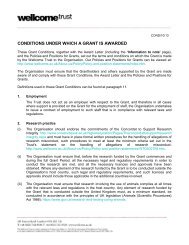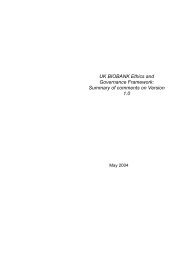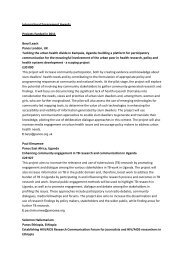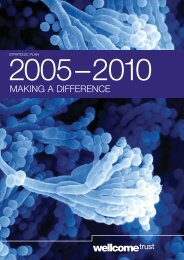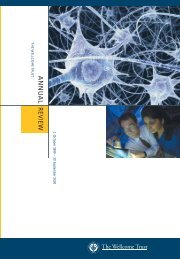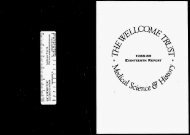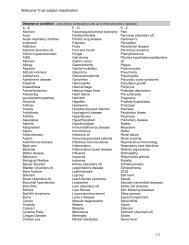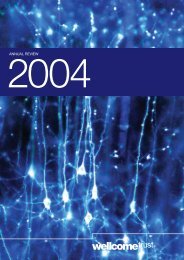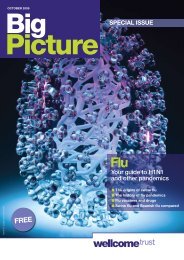You also want an ePaper? Increase the reach of your titles
YUMPU automatically turns print PDFs into web optimized ePapers that Google loves.
10 | advancing Knowledge<br />
Energy gap<br />
Cold cures<br />
Mitochondrial DNA mutations are<br />
surprisingly common.<br />
Not all pain is the same.<br />
1 2 3<br />
Mitochondria generate the bulk of the<br />
cell’s energy. Derived from once-freeliving<br />
bacteria, they retain the remnants<br />
of an ancestral genome, now down to<br />
its last 37 genes. Mutations in these<br />
genes cause a variety of conditions,<br />
typically affecting tissues with high<br />
energy needs, yet their full impact has<br />
been obscure. Now, Patrick Chinnery,<br />
Doug Turnbull and colleagues at<br />
Newcastle University have found that<br />
they affect significantly more people<br />
than previously thought.<br />
The Newcastle group used two<br />
approaches to assess the incidence of<br />
mitochondrial DNA mutations. One was<br />
to assess how many new mutations<br />
appeared in a series of more than 3000<br />
live births. One in 200 was found to carry<br />
a mutation not seen in their mother.<br />
In a complementary strand of work, the<br />
researchers calculated the prevalence of<br />
mutations in the working-age population<br />
around Newcastle, by analysing all<br />
suspected cases of mitochondrial<br />
disease seen at a neurology clinic<br />
between 1990 and 2004.<br />
By tracing family members, they found<br />
that 9.2 in 100 000 people had clinically<br />
apparent mitochondrial DNA disease,<br />
making it one of the most common<br />
inherited neuromuscular disorders.<br />
In addition, a further 16.5 in 100 000<br />
children and adults were at risk of<br />
mitochondrial DNA disease.<br />
The inheritance of mitochondrial DNA<br />
disorders is complex – the severity of<br />
symptoms varies widely in the offspring<br />
of affected mothers. Offspring get all their<br />
mitochondria from their mother, but if<br />
she has a mix of normal and mutant<br />
mitochondria, what decides whether they<br />
receive normal or affected mitochondria<br />
or a mix of both?<br />
The answer, it appears, is pure luck. When<br />
the Newcastle team looked at the<br />
precursors of egg cells created early in<br />
development, they discovered that the<br />
cells inherited a random selection of<br />
mutant and normal mitochondria. What<br />
an offspring ends up with simply depends<br />
on the fraction of mutant mitochondria in<br />
the egg that gets fertilised.<br />
Discovery of this ‘mitochondrial genetic<br />
bottleneck’ may provide an opportunity<br />
to screen out eggs with many mutant<br />
mitochondria, reducing the risk that a<br />
mother has a severely affected child.<br />
Schaefer AM et al. Prevalence of mitochondrial<br />
DNA disease in adults. Ann Neurol 2008;63(1):35–9.<br />
Elliott HR et al. Pathogenic mitochondrial DNA<br />
mutations are common in the general population.<br />
Am J Hum Genet 2008;83(2):254–60.<br />
Cree LM et al. A reduction of mitochondrial DNA<br />
molecules during embryogenesis explains the rapid<br />
segregation of genotypes. Nat Genet 2008;40(2):<br />
249–54.<br />
Many noxious insults trigger pain,<br />
such as heat, cold and tissue damage.<br />
All these insults are detected by<br />
pain-sensing neurons, nociceptors,<br />
which rapidly send messages to the<br />
spinal cord and then on to the brain.<br />
But there are subtle differences in how<br />
they are detected, and John Wood of<br />
University College London and<br />
colleagues are unpicking the cellular<br />
mechanisms that distinguish different<br />
types of pain.<br />
Although cold tends to inhibit our sensory<br />
and motor systems, pain perception is<br />
not affected – it serves a valuable defence<br />
function. To explore the mechanisms<br />
underlying this effect, Professor Wood’s<br />
team examined the function of key<br />
nociceptor sodium channels, the<br />
activation of which triggers a nerve<br />
impulse and ultimately leads to the<br />
sensation of pain.<br />
While the activity of most types of channel<br />
dropped when skin was cooled, that of<br />
one specific channel – known as Na v 1.8<br />
– was unaffected. Moreover, chilling<br />
actually lowered the threshold at which<br />
Na v 1.8 channels opened. Thus Na v 1.8<br />
appears to be the crucial element of cold<br />
pain sensing by nociceptors.<br />
But are there specific nociceptors for pain<br />
or does each sensory neuron detect a<br />
range of stimuli? To address this question,<br />
Professor Wood used a toxin to eliminate<br />
Images<br />
1 Mitochondria, the cell’s source of energy.<br />
2 Cardiac muscle stained for mitochondria.<br />
3, 4 Toxin-induced elimination of Na v 1.8 neurons (green).<br />
5, 6 Chromosomes (blue) are moved in dividing cells by microtubules<br />
(red), which attach to kinetochores (green)



